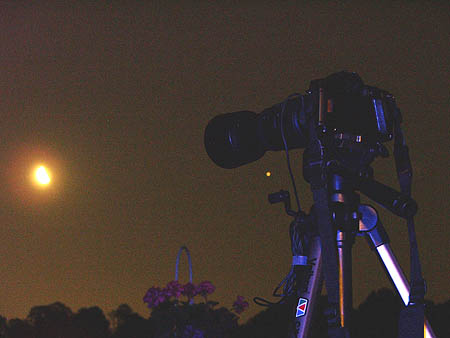
I caught something zip across the sky the other night. It seemed too fast to be an airplane and my first thought was perhaps it was ISS. I’ve heard you can see this from earth with the naked eye and with any old cheap telescope you can see the ISS solar array.
I dug around on-line for a site that tracked the movements of ISS and ran across heavens-above.com. It contains a rather large database of satellites, when they pass over your house, and where to look for them. A pretty cool website.
It seems what I saw was not ISS but a US military recon satellite. Shhhh. Don’t tell.
Several nights later (being tonight) I thought I’d dig around for software that will track what stars are where, where planets are at the moment, and other neat stuff of that nature.
I found a very nice piece of freeware called Cartes du Ciel. which has about anything one would want in amature star gazing software.
I’d write out the details of this software but I’m a lazy bastard sometimes. Therefore, copy/paste is my friend.
Their website says this:
“This program enables you to draw sky charts, making use of the data in 16 catalogs of stars and nebulae. In addition the position of planets, asteroids and comets are shown.
The purpose of this program is to prepare different sky maps for a particular observation. A large number of parameters permit you to choose specifically or automatically which catalogs to use, the colour and dimension of stars and nebulae, the representation of planets, the display of labels and coordinate grids, the superimposition of pictures, the condition of visibility and more.
These features make this celestial atlas more complete than a conventional planetarium. ”
Worth a look if you’re into this sort of thing.
Now to change the subject.
A few months back I picked up a remote shutter release for my Minolta SLR. This was kind of a hard thing to find locally as it’s not a standard plunger type – it’s an electronic switch. I suppose I could have made one, but like I said above, I can be a lazy bastard sometimes.
I bought the shutter release because I like taking night pictures, which can be tricky without one. When the Hale-Bopp comet was around in 1997 I managed to snap some extended shutter shots using the timer. I set up the shot, set how long I wanted the shutter open, hit the timer and waited. It worked, but remote releases area much easier.
Today I bought a 2x Tele Converter for the Minolta (the kind that fit between the body and the lens – not the kind that screw to the end of the lens). I was hoping if I coupled that with my 70-300mm telephoto lens I’d be able to get some nice moon pictures. I snapped a few 4 second and two second exposures on Kodak Max 800 film. I also tried to grab a shot of Vega and one of Mars. I think those will blur out with the 30 second exposure though.
And, to be ultra-dorky, I took a 3 second exposure digital picture of the Minolta with the 70-300mm fully extended in the middle of a 4 second exposure of the moon. You couldn’t see the camera on my first attempt (black camera, black sky, no light) so the next exposure I hit it with the blue LED light I have on my keychain.

Leave a Reply